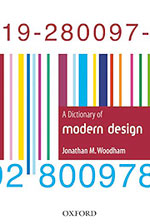Oxford University Press published the hardback edition of A Dictionary of Modern Design at the end of October
15 Aug 2013
A Dictionary of Modern Design: A new publication by Professor Jonathan Woodham
 Oxford University Press published the hardback edition of A Dictionary of Modern Design by Professor Jonathan Woodham (Director of the Centre for Research Development, Arts and Architecture) at the end of October; the paperback version will follow in October 2005. Over 500 pages long, the Dictionary covers a wide range of designers, writers, critics, theorists, manufacturers, retailers, educational institutions, design promotional and professional organisations, materials, museums, heritage sites and terminology from the mid-nineteenth century to the present day.
Oxford University Press published the hardback edition of A Dictionary of Modern Design by Professor Jonathan Woodham (Director of the Centre for Research Development, Arts and Architecture) at the end of October; the paperback version will follow in October 2005. Over 500 pages long, the Dictionary covers a wide range of designers, writers, critics, theorists, manufacturers, retailers, educational institutions, design promotional and professional organisations, materials, museums, heritage sites and terminology from the mid-nineteenth century to the present day.
One of the underlying aims of the dictionary was to redefine the territory of design history in ways that reflect the changing nuances of the word ‘design’ and ‘designer’ over the period covered. By the early 21st century such terms have become so pervasive in everyday language that their meanings have become increasingly dissipated. In addition to epithets such as ‘designer labels’ and ‘designer clothes’ that emerged in the 1960s, other increasingly ubiquitous descriptors that entered the everyday vocabulary in the 1980s such as ‘designer water’, ‘designer drugs’ and ‘designer stubble’, began to render the word ‘designer’ less meaningful. The fact that design has come to embrace an ever-widening range of meanings of design is reflected in the dictionary’s subject coverage that includes the ordinary and the everyday alongside more conventional design landmarks and individuals. Hence, for example, entries under the letter ‘S’ include the design rationale of the internationally pervasive Starbucks coffee lounges as well as that of the Siemens, Sony and Swatch corporations, the outlook of mail order enterprise Sears Roebuck & Co, the marketing appeal of Sindy dolls (manufactured by Pedigree Toys), and the contrasting design philosophies of the Saab and Skoda automobile companies. Mainstream developments such as Semiotics, Shaker Design, Sezessionstil, the Stockholm Exhibition of 1930, Streamlining and Swiss Style are also addressed alongside the achievements of organisations such as the Salon des Arts Ménagers, the Svenska Slöjdföreningen and Stichting Goed Wonen, of journals such as Stile Industria, and of numerous individuals. Those under ‘S’ include Gottfried Semper, Margarete Schütte-Lihotsky, Herbert Spencer, Borek Sípek, Yuri Soloviev, Yves Saint-Laurent and Philippe Starck.
Critical accounts of design production, consumption and the industrialisation process are also included throughout the dictionary, ranging from Pugin to Packard, Papanek, Illich and Klein as well as such as highlighting concepts such as Design for Need and Green Design (and its inherent contradictions). Jonathan Woodham has attempted to take on a wider geographical coverage of entries than most other dictionaries of design, although design history studies are only at a transitional phase of research into design in countries outside the nexus of the first industrialised world.
It may be of interest to note that Jonathan Woodham’s earlier text for Oxford University Press, Twentieth Century Design (1997), has now sold 39,000 copies worldwide and is currently being translated for publication in South Korea in late 2005.